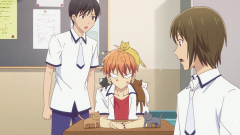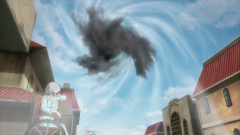Sarazanmai spends this episode on the remaining lead of the trio, Enta, and answers some questions, while at the same time, asks more question into the mix. I’ll be honest, while I still enjoy this episode immensely, I find this episode my least favorite so far of Sarazanmai, by a small margin. Most of that because I find Enta’s the least intriguing character out of the lead trio. If you are about to scream at my face with “WHAT”, I said that because apart from his queer crush (which is totally risque and admirable by the way) to Kazuki, there’s not much about him we can elaborate on. True, there’s also his older sister who gets herself into bizarre situation this time, which I will get to that later, but I don’t feel much of a emotional connection here. His mind is squarely about Kazuki and about wanting to express his love to Kazuki (to the point of multiple hilarious day-dreaming) that it overshadows everything else. A dealbreaker for me for now is that we don’t learn anything about Kazuki’s response towards Enta’s crush. When you think about it, the Memory Leaking would inform Kazuki very well about Enta’s affection towards him, but he acts totally oblivious. If by next week, Sarazanmai doesn’t address this issue I’d certainly feel very cheated and I’m gonna mark the show down for that.
The way Sarazanmai introduces the its bizarre theme of this week, on the other hand, is pure genius. It starts with Enta’s kiss, which was the cliffhanger from last week. It both serves as a continuity, and much later on do we learn that everything happens in this episode have to do with the “kiss” puns – kisu fish, the kiss, and the poor criminal named KISU who steals women’s kisses and transforms them into kisu fish. Ikuhara, you’ve got a perfect 100% score for originality here!! Of course, “kiss” theme here has to do with Enta’s affection towards his childhood friend, as they were together as a golden duo during their soccer team together, and he considers their playground as his sanctuary. It’s certainly praiseworthy to see him so determined to express his feeling for Kazuki, but for an Ikuhara show I would prefer them to deal with it right way, and not fake out by presenting them as Enta’s fantasy. It still works in this episode, I just hope that it won’t remain the case in the next ones. His sister, who we see interacts with him in several occasions, eventually gets mixed into this week’s phenomenal, but I feel that plot thread is under-developed in order to squeeze out some thematic relevance about it.
With this episode, we also learn that the Cops trying to capture and turn these criminals into Kappa Zombie in order to extract and store up their Desire, and they are served under sone Kingdom, which for now my take is that that Kingdom has totally opposite functions compare to that of Prince Kappi. We also learn that the person who becomes Kappa Zombie will have their existence erased if they get their shirikodama pulled out from their butt. At this moments, there’s a lot of mystery behind this world – with Ikuhara, nothing is ever straightforward – but at the same times, we get enough information and characters’ motivation that we don’t feel lost of overwhelmed over the huge amount of symbolisms. While narratively it’s not as complex or fresh than the first two weeks, this week gains a huge bonus point for its sheer determination of portraying queer crush of a middle-schooler kid. Speaking of that, Ikuhara’s latest interview, where he admitted that he didn’t mention “butt” in his pitch, but added later on instead, is pure bliss. It’s so Ikuhara thing to do and it is another statement for an auteur who isn’t afraid of back down on their own idea, even to a fault. And that is exactly why I always admire the man. We, as the audience, will have to follow their vision and whatever they cook up with, not the other way around.















































